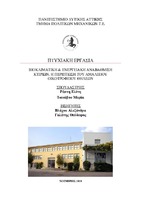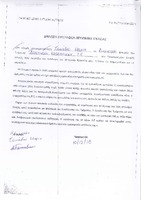| dc.contributor.advisor | Βλάχου, Αλεξάνδρα | |
| dc.contributor.advisor | Γαλάνης, Θεόδωρος | |
| dc.contributor.author | Τσινάβου, Μαρία | |
| dc.contributor.author | Ράπτη, Ελένη | |
| dc.date.accessioned | 2018-12-11T07:48:49Z | |
| dc.date.available | 2018-12-11T07:48:49Z | |
| dc.date.issued | 2018-11 | |
| dc.identifier.uri | http://okeanis.lib2.uniwa.gr/xmlui/handle/123456789/4716 | |
| dc.description.abstract | Το Αμαλίειον Οικοτροφείον Θηλέων, το οποίο σήμερα εδράζεται στο Μαρούσι, ιδρύθηκε το 1855, με στόχο την περίθαλψη και φροντίδα κοριτσιών που έμειναν ορφανά λόγω της τότε θανατηφόρας ασθένειας, της χολέρας, και λειτουργεί μέχρι σήμερα, πλέον ως σπουδαστική εστία. Σκοπός αυτής της εργασίας είναι η μελέτη της υπάρχουσας κατάστασής του, και στη συνέχεια, η πρόταση τρόπων για την Βιοκλιματική και Ενεργειακή Αναβάθμισή του. Αναλυτικότερα, στο 1ο κεφάλαιο της εργασίας μας, παρουσιάζονται τα προβλήματα του 21ου αιώνα. Στο 2ο κεφάλαιο, αναλύονται οι ορισμοί της βιώσιμης ανάπτυξης, της ισχυρής και ασθενούς βιωσιμότητας και γίνεται αναφορά στο πρωτόκολλο του Κιότο. Στο 3ο και 4ο κεφάλαιο, γίνεται λόγος για την βιοκλιματική δόμηση και τον βιοκλιματικό σχεδιασμό κτιρίων, καθώς επίσης και στα στοιχεία αυτού. Στο 5ο κεφάλαιο της εργασίας, παρουσιάζονται τα οικολογικά δομικά υλικά και τα υλικά θερμομόνωσης, ενώ στο 6ο κεφάλαιο, γίνεται λεπτομερής ανάλυση των Ανανεώσιμων Πηγών Ενέργειας. Στο 7ο κεφάλαιο, παρατίθενται παραδείγματα βιοκλιματικών κτιρίων σε Ελλάδα και Εξωτερικό ενώ στο 8ο κεφάλαιο παρουσιάζεται η ιστορική αναδρομή του Οικοτροφείου, καθώς επίσης, και η υπάρχουσα κατάστασή του, τόσο εσωτερικά, όσο και εξωτερικά, με την βοήθεια σχεδιαστικού και φωτογραφικού υλικού. Ολοκληρώνοντας, στο 9ο κεφάλαιο, παρουσιάζονται προτάσεις για βιοκλιματική αναβάθμιση γενικότερα αλλά και συγκεκριμένα του Οικοτροφείου, με κατακλείδα την αξιολόγηση αυτών. | el |
| dc.format.extent | 203 | el |
| dc.language.iso | el | el |
| dc.publisher | Α.Ε.Ι. Πειραιά Τ.Τ. | el |
| dc.rights | Αναφορά Δημιουργού-Μη Εμπορική Χρήση-Όχι Παράγωγα Έργα 3.0 Ελλάδα | * |
| dc.rights.uri | http://creativecommons.org/licenses/by-nc-nd/3.0/gr/ | * |
| dc.subject | TPSH::Αρχιτεκτονική - Πολεοδομία::Βιοκλιματική Αρχιτεκτονική | el |
| dc.subject | TPSH::Τεχνολογία::Δομική Μηχανική::Κτίρια | el |
| dc.title | Βιοκλιματική και ενεργειακή αναβάθμιση κτιρίων. Η περίπτωση του Αμαλιείου Οικοτροφείου Θηλέων | el |
| dc.title.alternative | Bioclimatic and energy upgrading of buildings. The case of Amalieion Women's Boarding School | el |
| dc.type | Πτυχιακή εργασία | el |
| dc.contributor.committee | Βλάχου, Αλεξάνδρα | |
| dc.contributor.committee | Γαλάνης, Θεόδωρος | |
| dc.contributor.committee | Δημοπούλου, Ελένη | |
| dc.contributor.department | Τμήμα Πολιτικών Μηχανικών Τ.Ε. | el |
| dc.contributor.faculty | Σχολή Τεχνολογικών Εφαρμογών | el |
| dc.subject.keyword | Αμαλίειο Οικοτροφείο Θηλέων | el |
| dc.subject.keyword | Ενεργειακή αναβάθμιση | el |
| dc.subject.keyword | Βιώσιμη ανάπτυξη | el |
| dc.subject.keyword | Βιοκλιματικός σχεδιασμός | el |
| dc.subject.keyword | Οικολογική δόμηση | el |
| dc.description.abstracttranslated | The Amalieion women’s boarding school, which is based in Maroussi of Athens, was founded in 1855 with the aim of providing care for girls who lost their parents by the deadly disease of those times, cholera, and is still functioning as a student hub. The purpose of this paper work is to study its existing situation, and propose ways for a bioclimatic and energy upgrading of it. In more detail, in the first chapter of our paper, the problems of the 21st century are presented. In Chapter 2, the definitions of sustainable development, strong and poor sustainability are analyzed, and reference is made to the Kyoto Protocol. In the third and the fourth chapter, the bioclimatic structure and the bioclimatic design of buildings, as well as the elements included, are discussed. In the 5th chapter of the paper, the ecological building materials and the thermal insulation materials are presented, while in the 6th chapter a detailed analysis of the Renewable Energy Sources is made. In the 7th chapter, examples of bioclimatic buildings in Greece and abroad are presented, while in the 8th chapter the historical retrospective of the Boarding School is also presented, as well as its existing situation, both internally and externally, with the aid of design and photographic material. Finally in chapter 9, general bioclimatic upgrading proposals are made as well as proposals specific to the boarding school, with their final evaluation. | el |



